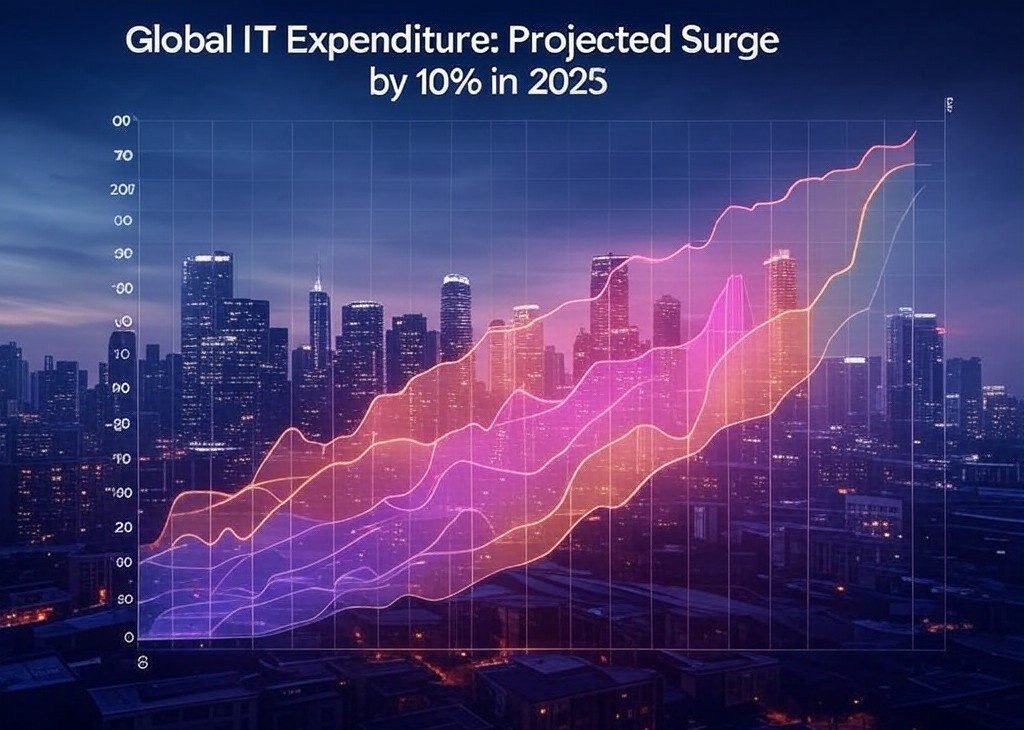Title: The Future of IT Spending in India: Insights and Trends for 2025
The Future of IT Spending in India: Insights and Trends for 2025
As we approach 2025, the landscape of IT spending in India is poised for significant changes. A recent study reveals that 61% of Indian executives express optimism about their organizations’ prospects, a noticeable increase from 53% in 2024. This growing confidence comes at a time when worldwide IT spending is expected to reach $5.61 trillion, reflecting a 9.8% increase from the previous year, as per Gartner’s latest forecast. In India specifically, IT spending is projected to grow by 11.1%, amounting to $161.51 billion. However, while these figures may seem promising, the reality of escalating costs presents a complex picture for Chief Information Officers (CIOs) and their budgetary strategies.
Understanding the Financial Landscape for CIOs
Despite the rise in IT budgets, a substantial portion of these increases is likely to be absorbed by rising costs. John-David Lovelock, distinguished VP analyst at Gartner, states, “While budgets for CIOs are increasing, a significant portion will merely offset price increases within their recurrent spending.” This observation highlights a critical issue: as nominal spending rises, the actual growth in IT expenditure may be skewed when adjusted for inflation and other cost increases. CIOs are thus faced with a challenging environment where even as their budgets grow, the real buying power may remain stagnant.
The pressure of higher-than-expected prices across all major IT categories has led many CIOs to reconsider their spending strategies. Lovelock emphasizes that these rising costs are prompting CIOs to defer and scale back their true budget expectations. As a result, organizations may find themselves in a position where they must prioritize certain IT investments over others to maintain operational viability.
Key Growth Segments in IT Spending
Even amidst rising costs, certain segments of IT spending are expected to experience robust growth. Notably, data center systems, devices, and software are anticipated to witness double-digit growth in 2025. This surge is largely driven by the demand for generative AI (GenAI) hardware upgrades, although these upgrades may not significantly enhance functionality. Lovelock notes, “GenAI is sliding toward the trough of disillusionment, which reflects CIOs’ declining expectations for GenAI but not their spending on this technology.”
The rise in purchases of AI-ready PCs and devices illustrates this trend. While these AI-enabled products are gaining traction among both consumers and enterprises, their actual impact on business operations may be limited without the necessary applications to leverage their capabilities fully. This disconnect signifies a period of adjustment for organizations as they navigate the complexities of integrating new technologies into their existing frameworks.
AI-Optimized Servers: A Double-Edged Sword
A particularly noteworthy trend is the projected spending on AI-optimized servers, which is expected to double that of traditional servers by 2025, reaching an astounding $202 billion. Lovelock highlights that “IT services companies and hyperscalers account for over 70% of spending in 2025.” This shift underscores the growing importance of AI in shaping future IT infrastructures. By 2028, hyperscalers are forecasted to operate $1 trillion worth of AI-optimized servers, although these will not function within their traditional business models or Infrastructure as a Service (IaaS) markets. Instead, hyperscalers are pivoting to become integral players in the oligopoly AI model market, redefining the competitive landscape.
In India, the data center systems segment is projected to nearly double its growth rate from 2024, with an impressive increase of 19.1%. As Naveen Mishra, VP Analyst at Gartner, points out, “Enterprises are investing in AI-ready infrastructure for targeted use cases.” This trend reflects the growing recognition among Indian companies of the necessity to upgrade their technological foundations to remain competitive in a rapidly evolving market.
Software and IT Services: Pillars of Growth
Software and IT services are expected to remain vital contributors to the growth of India’s IT spending. With anticipated increases of 16.9% and 11.2% respectively, these sectors are set to play a crucial role in the overall IT landscape. Mishra explains that “while software spending is propelled by the price premium of GenAI-enabled solutions, IT services spending is fueled by enterprises’ need for cloudification, digitization, and consulting services.”
The shift towards cloud services and digital transformation is a clear indicator of where organizations are directing their investments. As businesses increasingly recognize the importance of agility and scalability, the demand for cloud solutions continues to rise. By 2026, Gartner predicts that more than 50% of software spending in application software will be influenced by GenAI. This trend will further drive investment in tools and platforms essential for deploying, managing, and scaling AI technologies effectively.
Capgemini’s Insights: A Beacon of Optimism
In addition to Gartner’s predictions, Capgemini’s report titled “Navigating Uncertainty with Confidence – Investment Priorities for 2025” offers a complementary perspective on the outlook for business leaders amidst market uncertainties. The study reveals a significant number of Indian executives—61%—expressing optimism about their organizations’ futures in 2025, an increase from 53% in 2024.
Moreover, 55% of Indian business leaders plan to increase their investments in 2025, surpassing the global average of 50%. This proactive stance on investment indicates a burgeoning confidence in the Indian market’s resilience and potential for growth.
The Role of Technology in Business Strategy
Technology continues to be a top priority for Indian businesses, with 75% of surveyed leaders identifying artificial intelligence (AI) and generative AI (GenAI) as the leading focus for investments in 2025. This figure slightly exceeds the global average of 74%. Following closely is cloud technology, with 46% of Indian leaders prioritizing it compared to 42% globally.
However, the report also highlights a strategic pivot towards operational efficiency. A notable 55% of Indian executives prioritize cost reduction over revenue growth in 2025. This focus on efficiency may signal a shift in how organizations approach their spending, emphasizing the need for sustainable growth rather than rapid expansion.
Conclusion
As we look toward 2025, the landscape for IT spending in India presents both opportunities and challenges. The optimism expressed by Indian executives is buoyed by anticipated growth in various IT segments, particularly those related to AI and cloud technologies. However, the reality of rising costs and the need for strategic investment decision-making cannot be overlooked.
The insights provided by research from Gartner and Capgemini underscore the necessity for organizations to navigate these complexities with foresight and agility. By investing in AI-ready infrastructures and embracing digital transformation, Indian businesses can position themselves to thrive in an increasingly competitive environment. As technology continues to evolve, organizations must remain adaptable, ensuring their strategies align with the changing dynamics of the market. Ultimately, the successful navigation of this landscape will depend on a balanced approach that prioritizes both innovation and operational efficiency.




